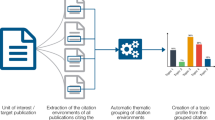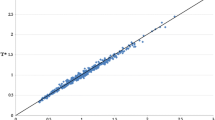Abstract
A novel method of displaying the publication and citation characteristics of outputs of researchers using a graphical "footprint" has been developed. Its first application has been to compare the publication and citation characteristics of a small group of top UK, and US academic chemical engineers. The footprint demonstrates the Relationship Factors of publications in a number of related disciplines, as defined by ISI's Journal Citation Reports. The technique has been used to compare both individual academics and each national group as a whole. The results clearly show that US academic chemical engineers are far more interdisciplinary in their output than their UK counterparts. The technique has a number of potential applications, including tracking changes in a discipline over time, tracking individual academics' output over time, and comparing different disciplines for their interdisciplinarity.
Similar content being viewed by others
References
BURTON, R. E., Citations in American engineering journals: chemical engineering, American Documentation, 10 (1959) 70.
GARFIELD, E., Journal Citation Studies 21, Engineering journals, Current Contents, 27 (July 7, 1975) 5–10.
PETERS, H. P. F., VAN RAAN, A. F. J., Structuring scientific activities by co-author analysis, Scientometrics, 20 (1991) 235–255.
PETERS, H. P. F., HARTMANN, D., VAN RAAN, A. F. J., Monitoring advances in chemical engineering. In: EGGHE, L., ROUSSEAU, R. (Eds), Informetrics 87/88, Elsevier, Amsterdam, 1988, pp. 175–195.
MILMAN, B. L., GAVRILOVA, Y. A., Analysis of citation and co-citation in chemical engineering, Scientometrics, 27 (1993) 53–74.
MILMAN, B. L., Individual co-citation clusters as nuclei of complete and dynamic informetric models of scientific and technological areas, Scientometrics, 31 (1994) 45–57.
SEDLACEK, J., RYSAVY, P., KOPECKY, V., Statistical analysis of information sources in the field of chemical engineering, Technicka Knihovna, 28 (1984) 329–340.
SEDLACEK, J., Statistical analysis of publications in the sphere of chemical engineering, Technicka Knihovna, 33 (1989) 39–48.
BRAUN, T., GLÄNZEL, W., GRUPP, H., The scientometric weight of 50 nations in 27 science areas, 1989–1993, Scientometrics, 33 (1995) 263–293.
HART, P. W., SOMMERFIELD, J. T., Relationship between growth in GDP and growth in the chemical engineering literature in five different countries, Scientometrics, 42 (1998) 299–311.
SCHUBERT, A., The profile of the Chemical Engineering Journal and Biochemical Engineering Journal as reflected in its publications, references and citations, 1983.1996, Chemical Engineering Journal, 69 (1998) 151–156.
MCCAIN, K. W., Biotechnology in context: a database filtering approach to identifying core and productive non-core journals supporting multidisciplinary R&D, Journal of the American Society for Information Science, 46 (1995) 306–317.
MIL'MAN, B. L., GAVRILOVA, Y. A., Cluster analysis of bibliographic references as a method of scientometric analysis of general chemical engineering, Nauchno-Tekhnicheskaya Informatsiya, 12 (1990) 24–28.
PETERS, H. P. F., BRAAM, R. R., VAN RAAN, A. F. J., Cognitive resemblance and citation relations in chemical engineering publications, Journal of the American Society for Information Science, 46 (1995) 9–21.
VAN VIANEN, B. G., MOED, H. F., VAN RAAN, A. F. J., An exploration of the science base of recent technology, Research Policy, 19 (1990) 61–81.
Chemistry that counts: the frontrunners in four fields, Science Watch, 3 (1992) 1–8.
OGAWA, H., MIDORIKAWA, N., YOSHIKAWA, C., SAITO, K., ITSUMURA, H., KANEKO, M., NIKI, E., How much of cited conference materials can be found using bibliographic tools? Journal of the American Society for Information Science, 40 (1989) 350–355.
ZHU, J., MEADOWS, A. J., MASON, G., Citations and departmental research ratings, Scientometrics, 21 (1991) 171–179.
MACROBERTS, M. H., MACROBERTS, B. R., Problems of citation analysis: a critical review, Journal of the American Society for Information Science, 40 (1988) 342–349.
PRAGIER, G., RONAYNE, J., A criticism of the use of citation analysis in studying the science-technology relationship, Journal of Chemical Information and Computer Sciences, 15 (1975) 155–157.
PETERS, H. P. F., VAN RAAN, A. F. J., Co-word based science maps of chemical engineering, Research Policy, 22 (1993) 23–71.
VAN RAAN, A. F. J., Peters, H. P. F., Dynamics of a scientific field analysed by co-subfield structures, Scientometrics, 15 (1989) 607–620.
PETERS, H. P. F., VAN RAAN, A. F. J., On determinants of citation scores: a case study in chemical engineering, Journal of the American Society for Information Science, 45 (1994) 39–49.
PETERS, H. P. F., VAN RAAN, A. F. J., A bibliometric profile of top scientists: a case study in chemical engineering, Scientometrics, 29 (1994) 115–136.
BAIRD, L. M., OPPENHEIM, C., Do citations matter?, Journal of Information Science, 20 (1994) 2–15.
ANGELA MARTELLO, Senior Editor, Science Editorial Development, ISI, personal communication.
MOED, H. F., VAN LEEUWEN, T. N., Improving the accuracy of ISI.s journal impacxt factors, Journal of the American Society for Information Science, 46 (1995) 461–467.
DONDIS, D. A., A primer of visual literacy, The MIT Press (1973); TUFTE, E. R., The visual display of quantitative information, Graphics Press (1982).
GOLDER, W, Who controls the controllers? Ten statements on the so-called impact factor, Onkologie, 23 (2000) 73–75.
Chemical Engineering Frontiers, Research Needs and Opportunities (The Amundson Report), National Research Council, Washington DC, 1988.
SHAMA, G., HELLGARDT, K., Spreading the Word (About Chemical Engineering), Chemical Engineering Education (2000) in the press.
DOE, R., HELLGARDT, K., OPPENHEIM, C, SHAMA, G., unpublished results.
Author information
Authors and Affiliations
Rights and permissions
About this article
Cite this article
Shama, G., Hellgardt, K. & Oppenheim, C. Citation Ootprint Analysis Part I: UK and US Chemical Engineering Academics. Scientometrics 49, 289–305 (2000). https://doi.org/10.1023/A:1010573220173
Issue Date:
DOI: https://doi.org/10.1023/A:1010573220173




